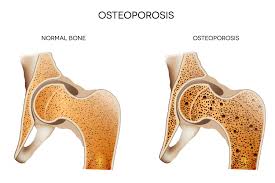
Osteoporosis is a systemic disorder characterized by generalized decrease in bone density. It occurs when the body loses too much bone, makes too little bone, or both. As a result, bones become weak and may break from a fall or, in serious cases, from minor things like sneezing or minor bumps.
Osteoporosis means “porous bone.” When viewed under a microscope, healthy bone looks like a honeycomb, with small holes. When osteoporosis occurs, the holes and spaces in the honeycomb are much larger than in healthy bone. Osteoporotic bones have lost density or mass and contain abnormal tissue structure. As bones become less dense, they weaken and are more likely to break. Of the estimated 54 million Americans with osteoporosis, about eight million or 80% are women. Approximately one in two women, and one on four men over age 50 will break a bone because of osteoporosis.
There are several reasons why women are more susceptible to Osteoporosis than men:
o Women tend to have thinner, smaller bones than men.
o The amount of Estrogen, a hormone in women that protects bones, decreases sharply when women reach menopause, which can cause bone loss. This is why the chance of developing osteoporosis increases as women reach menopause.
Osteoporosis also affects the jaw bones and Bisphosphonates (like Fosamax or Boniva) are often the first line of therapy. Bisphosphonates have been used for the past 40 years for the treatment of Osteoporosis, Paget’s disease and few other conditions. The aim of Bisphosphonate use is to achieve a normal bone remodeling level.
WILL OSTEOPOROSIS PREVENT ME FROM BEING ABLE TO GET IMPLANTS?
Many patients question whether or not Bisphosphonate use is a contraindication for implant placement. Many studies have been done on this. The literature states that patients with osteoporosis do not appear to be at a significant risk of implant failure. In other words: The good news is that having Osteoporosis is not a contraindication for dental implants.
Successful dental implants rely on a series of clinical and biological factors such as bone height, width, density, the implant’s initial primary stability and eventual osseointegration. (Osseointegration, is derived from the Greek and Latin terms for “bone” and “to make whole”. Osseointegration is the process that allows dental implants to become a permanent part of your jaw.)
RISKS AND BENEFITS OF MEDICATION (text below from Harvard.edu website):
https://www.health.harvard.edu/womens-health/taking-osteoporosis-drugs-shouldnt-prevent-you-from-getting-oral-surgery
“Are these drugs really risky for your oral health? The answer is no. The people at highest risk for osteonecrosis are not people taking these medications for osteoporosis, but rather those taking very high doses of the drugs, delivered intravenously as part of cancer treatment, says Dr. August. Women who are taking the drugs orally for osteoporosis are at far lower risk for the condition.”
THE BOTTOM LINE
Dental Implantology is a specialty with high predictability (a 95% success rate) when both quantity and quality of the bone are respected. Therefore, the diagnosis and the implant treatment planning in patients with osteoporosis are important.
Having Osteoporosis are not a contraindication for dental implant treatment. Osteoporosis should not preclude implant treatment option for patients seeking dental care. A thorough, individual benefit/risk assessment will lead to a predictable prognosis.
If you’re in need of dental treatment and this is a concern of yours, call us at 214-956-9100 or CONTACT US here to schedule a complimentary consultation with us to discuss your individual needs. We’ll develop a plan that’ll allow you to get the treatment you need with predictable success.






